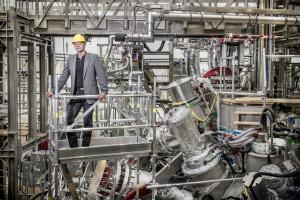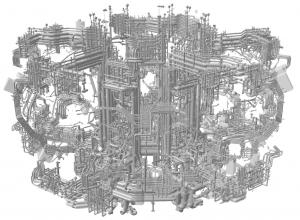What are the next steps for the Wendelstein project?
These results were promising but have also shown limits. An input heating energy of 200 MJ is the maximum we can allow without causing damage to the wall components. The formula is simple: the heat generated by the injected energy has to go somewhere. So far, this happens by inertial cooling.
The next step is the installation of components in the vacuum vessel that are actively water-cooled. We will replace the current divertor with actively cooled divertor modules and will connect all wall elements to the water cooling system, which is a complex spider web of water pipes permeating the entire device (see image at right).
To prepare for these optimizations we are now in a two-year shutdown phase until the end of 2020, during which we will finalize the installation of the actively water-cooled system and start commissioning.
Tokamak vs stellarator: both projects will continue to be pursued in parallel ...
It's not a competition—we need to develop fusion as a clean, safe and reliable source of energy for the future. Both projects have their place in this ambitious endeavor and both systems have advantages and disadvantages.
The tokamak achieves better plasma performance in terms of temperature, density and confinement, but disruptions—now a major research topic in tokamak physics—can be a challenge. Stellarators on the other hand are disruption-free machines, however you pay the price by having to build a device with a challenging geometry. In the past, the performance of the stellarator could never match that of the tokamak, but it is now catching up and with upcoming optimizations some of the performance-related disadvantages can be overcome.
This week you presented the Wendelstein 7-X project at the 6th FuseNet PhD meeting at ITER Headquarters. What did you take away from that meeting?
Fusion always has been, is and always will be a generation-spanning project. Fusion is a challenge too big to be solved within a lifetime. Therefore, we need to have handover from one generation to the next. In fact, it's already a very smooth process; there is a permanent transfer of knowledge to the younger generation of fusion experts. It was good to see that the students are looking at both fusion device options. There is a completely natural mix of study topics related to tokamaks and stellarators.
Read more about Wendelstein 7-X here.



